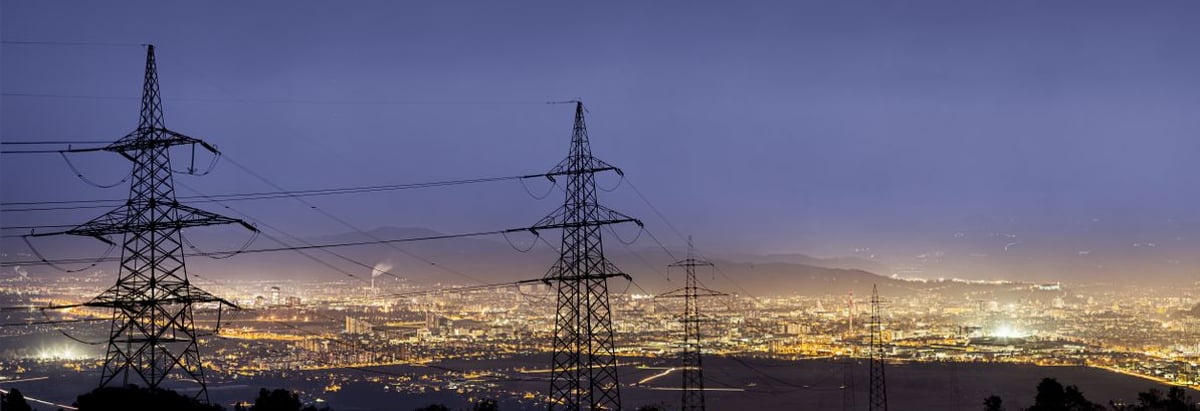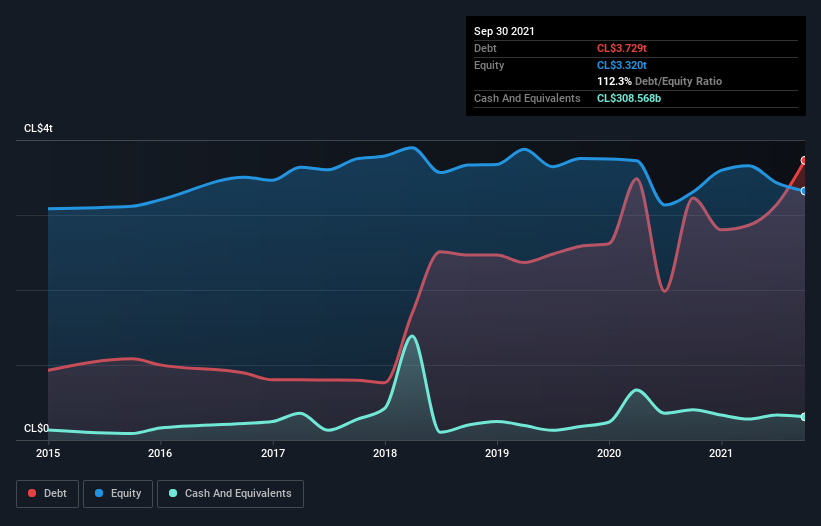
Some say volatility, rather than debt, is the best way to think about risk as an investor, but Warren Buffett famously said that 'Volatility is far from synonymous with risk.' It's only natural to consider a company's balance sheet when you examine how risky it is, since debt is often involved when a business collapses. We note that Enel Chile S.A. (SNSE:ENELCHILE) does have debt on its balance sheet. But is this debt a concern to shareholders?
When Is Debt Dangerous?
Debt is a tool to help businesses grow, but if a business is incapable of paying off its lenders, then it exists at their mercy. If things get really bad, the lenders can take control of the business. While that is not too common, we often do see indebted companies permanently diluting shareholders because lenders force them to raise capital at a distressed price. By replacing dilution, though, debt can be an extremely good tool for businesses that need capital to invest in growth at high rates of return. The first step when considering a company's debt levels is to consider its cash and debt together.
View our latest analysis for Enel Chile
What Is Enel Chile's Debt?
The image below, which you can click on for greater detail, shows that at September 2021 Enel Chile had debt of CL$3.73t, up from CL$3.23t in one year. However, it also had CL$308.6b in cash, and so its net debt is CL$3.42t.

How Strong Is Enel Chile's Balance Sheet?
Zooming in on the latest balance sheet data, we can see that Enel Chile had liabilities of CL$1.56t due within 12 months and liabilities of CL$4.02t due beyond that. On the other hand, it had cash of CL$308.6b and CL$634.1b worth of receivables due within a year. So it has liabilities totalling CL$4.64t more than its cash and near-term receivables, combined.
This deficit casts a shadow over the CL$2.21t company, like a colossus towering over mere mortals. So we definitely think shareholders need to watch this one closely. At the end of the day, Enel Chile would probably need a major re-capitalization if its creditors were to demand repayment.
In order to size up a company's debt relative to its earnings, we calculate its net debt divided by its earnings before interest, tax, depreciation, and amortization (EBITDA) and its earnings before interest and tax (EBIT) divided by its interest expense (its interest cover). The advantage of this approach is that we take into account both the absolute quantum of debt (with net debt to EBITDA) and the actual interest expenses associated with that debt (with its interest cover ratio).
As it happens Enel Chile has a fairly concerning net debt to EBITDA ratio of 5.6 but very strong interest coverage of 11.3. So either it has access to very cheap long term debt or that interest expense is going to grow! Shareholders should be aware that Enel Chile's EBIT was down 31% last year. If that decline continues then paying off debt will be harder than selling foie gras at a vegan convention. When analysing debt levels, the balance sheet is the obvious place to start. But it is future earnings, more than anything, that will determine Enel Chile's ability to maintain a healthy balance sheet going forward. So if you want to see what the professionals think, you might find this free report on analyst profit forecasts to be interesting.
But our final consideration is also important, because a company cannot pay debt with paper profits; it needs cold hard cash. So we clearly need to look at whether that EBIT is leading to corresponding free cash flow. In the last three years, Enel Chile's free cash flow amounted to 32% of its EBIT, less than we'd expect. That weak cash conversion makes it more difficult to handle indebtedness.
Our View
On the face of it, Enel Chile's EBIT growth rate left us tentative about the stock, and its level of total liabilities was no more enticing than the one empty restaurant on the busiest night of the year. But at least it's pretty decent at covering its interest expense with its EBIT; that's encouraging. It's also worth noting that Enel Chile is in the Electric Utilities industry, which is often considered to be quite defensive. We're quite clear that we consider Enel Chile to be really rather risky, as a result of its balance sheet health. So we're almost as wary of this stock as a hungry kitten is about falling into its owner's fish pond: once bitten, twice shy, as they say. There's no doubt that we learn most about debt from the balance sheet. But ultimately, every company can contain risks that exist outside of the balance sheet. For instance, we've identified 3 warning signs for Enel Chile (1 is significant) you should be aware of.
At the end of the day, it's often better to focus on companies that are free from net debt. You can access our special list of such companies (all with a track record of profit growth). It's free.
Valuation is complex, but we're here to simplify it.
Discover if Enel Chile might be undervalued or overvalued with our detailed analysis, featuring fair value estimates, potential risks, dividends, insider trades, and its financial condition.
Access Free AnalysisThis article by Simply Wall St is general in nature. We provide commentary based on historical data and analyst forecasts only using an unbiased methodology and our articles are not intended to be financial advice. It does not constitute a recommendation to buy or sell any stock, and does not take account of your objectives, or your financial situation. We aim to bring you long-term focused analysis driven by fundamental data. Note that our analysis may not factor in the latest price-sensitive company announcements or qualitative material. Simply Wall St has no position in any stocks mentioned.
Have feedback on this article? Concerned about the content? Get in touch with us directly. Alternatively, email editorial-team (at) simplywallst.com.
About SNSE:ENELCHILE
Enel Chile
An electricity utility company, engages in the generation, transmission, and distribution of electricity in Chile.
Adequate balance sheet with moderate growth potential.
Market Insights
Community Narratives



